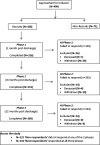A longitudinal, multicentre, cohort study of community rehabilitation service delivery in long-term neurological conditions
- PMID: 24583762
- PMCID: PMC3939653
- DOI: 10.1136/bmjopen-2013-004231
A longitudinal, multicentre, cohort study of community rehabilitation service delivery in long-term neurological conditions
Abstract
Objectives: Part A: To pilot the use of a register to identify and monitor patients with complex needs arising from long-term neurological conditions. Part B: To determine the extent to which patients' needs for health and social services are met following discharge to the community after inpatient rehabilitation; to identify which factors predict unmet needs and to explore the relationship between service provision and outcomes at 12 months.
Design: A multicentre, prospective, cohort study surveying participants at 1, 6 and 12 months using postal/online questionnaires and telephone interview.
Setting: Consecutive discharges to the community from all nine tertiary, specialist, inpatient neurorehabilitation services in London over 18 months in 2010-2011.
Participants: Of 576 admissions 428 patients were recruited at discharge: 256 responded at 4 weeks, 212 at 6 months and 190 at 12 months.
Measures: Neurological Impairment Scale, The Needs and Provision Complexity Scale, The Northwick Park Dependency Scale, Community Integration Questionnaire, Zarit Burden Inventory.
Results: n=322 (75%) expressed willingness to be registered, but in practice less than half responded to questionnaires at 6 and 12 months (49% and 44%, respectively), despite extensive efforts to contact them, with no significant differences between responders and non-responders. Significant unmet needs were identified within the first year following discharge, particularly in rehabilitation, social work support and provision of specialist equipment. Dependency for basic care and motor and cognitive impairment predicted services received, together accounting for 40% of the variance. Contra to expectation, patients whose rehabilitation needs were met were more dependent and less well integrated at 12 months post discharge than those with unmet needs.
Conclusions: Registration is acceptable to most patients, but questionnaires/telephone interviews may not be the most efficient way to reach them. When community resources are limited, service provision tends to be focused on the most dependent patients.
Registration: The study was registered with the NIHR Comprehensive Local Research Network: ID number 7503.
Keywords: Rehabilitation Medicine.
Figures


Similar articles
-
Service use and costs for people with long-term neurological conditions in the first year following discharge from in-patient neuro-rehabilitation: a longitudinal cohort study.PLoS One. 2014 Nov 17;9(11):e113056. doi: 10.1371/journal.pone.0113056. eCollection 2014. PLoS One. 2014. PMID: 25401992 Free PMC article.
-
An extended stroke rehabilitation service for people who have had a stroke: the EXTRAS RCT.Health Technol Assess. 2020 May;24(24):1-202. doi: 10.3310/hta24240. Health Technol Assess. 2020. PMID: 32468989 Free PMC article. Clinical Trial.
-
The Needs and Provision Complexity Scale: a multicentre prospective cohort analysis of met and unmet needs and their cost implications for patients with complex neurological disability.BMJ Open. 2013 Feb 22;3(2):e002353. doi: 10.1136/bmjopen-2012-002353. Print 2013. BMJ Open. 2013. PMID: 23435796 Free PMC article.
-
A casemix classification for those receiving specialist palliative care during their last year of life across England: the C-CHANGE research programme.Southampton (UK): National Institute for Health and Care Research; 2023 Nov. Southampton (UK): National Institute for Health and Care Research; 2023 Nov. PMID: 38048413 Free Books & Documents. Review.
-
Signposting services for people with health and care needs: a rapid realist review.Health Soc Care Deliv Res. 2024 Aug;12(26):1-86. doi: 10.3310/GART5103. Health Soc Care Deliv Res. 2024. PMID: 39239879 Review.
Cited by
-
Unmet rehabilitation needs in the first 6 months post-injury in a trauma centre population with moderate-to-severe traumatic injuries.J Rehabil Med. 2024 May 27;56:jrm40078. doi: 10.2340/jrm.v56.40078. J Rehabil Med. 2024. PMID: 38803207 Free PMC article.
-
Cost efficiency of inpatient rehabilitation following acquired brain injury: the first international adaptation of the UK approach.BMJ Open. 2024 Dec 22;14(12):e094892. doi: 10.1136/bmjopen-2024-094892. BMJ Open. 2024. PMID: 39806612 Free PMC article.
-
Unmet needs for healthcare and social support services in patients with Huntington's disease: a cross-sectional population-based study.Orphanet J Rare Dis. 2015 Sep 28;10:124. doi: 10.1186/s13023-015-0324-8. Orphanet J Rare Dis. 2015. PMID: 26411462 Free PMC article.
-
Development of a toolkit to enhance care processes for people with a long-term neurological condition: a qualitative descriptive study.BMJ Open. 2018 Jun 30;8(6):e022038. doi: 10.1136/bmjopen-2018-022038. BMJ Open. 2018. PMID: 29961034 Free PMC article.
-
Service use and costs for people with long-term neurological conditions in the first year following discharge from in-patient neuro-rehabilitation: a longitudinal cohort study.PLoS One. 2014 Nov 17;9(11):e113056. doi: 10.1371/journal.pone.0113056. eCollection 2014. PLoS One. 2014. PMID: 25401992 Free PMC article.
References
-
- Barnes MP, Rademacher H. Neurological rehabilitation in the community. J Rehabil Med 2001;33:244–8 - PubMed
-
- Altman IM, Swick S, Malec JF. Effectiveness of home- and community-based rehabilitation in a large cohort of patients disabled by cerebrovascular accident: evidence of a dose-response relationship. Arch Phys Med Rehabil 2013;94:1837–41 - PubMed
-
- Geurtsen GJ, van Heugten CM, Martina JD, et al. Comprehensive rehabilitation programmes in the chronic phase after severe brain injury: a systematic review. J Rehabil Med 2010;42:97–110 - PubMed
-
- Kendall E, Muenchberger H, Catalano T. The move towards community-based rehabilitation in industrialised countries: are we equipped for the challenge? Disabil Rehabil 2009;31:2164–73 - PubMed
-
- Jianjun Y, Yongshan H, Wu Y, et al. The effects of community-based rehabilitation on stroke patients in China: a single-blind, randomized controlled multicentre trial. Clin Rehabil 2009;23:408–17 - PubMed
Publication types
MeSH terms
Grants and funding
LinkOut - more resources
Full Text Sources
Other Literature Sources
Medical
Miscellaneous
